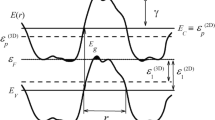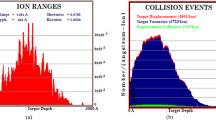Abstract
A quantitative correlation between R-line luminescence at around 1.37 μm and {311} defect nature, size and concentration has been undertaken in silicon, following keV Si-implantation and subsequent annealing using photoluminescence spectroscopy and plan-view transmission electron microscopy. The formation and evolution of the rod-like defects were found to be dependent on annealing time at a temperature of 700 °C, but there was no simple correlation found between the density and size of those defects and the R-line intensity. In particular, whereas the presence of {311} defects is essential for observing R-line luminescence, both very small {311} defects at short annealing times and fully developed {311} defects at long annealing times do not contribute to such luminescence. We provide possible explanations for this behavior and suggest that the local (strain) environment around defects, the dopant level and impurities in the silicon substrate may all play a role in determining R-line intensity.




Similar content being viewed by others
References
E. Chason, S.T. Picraux, J.M. Poate, J.O. Borland, M.I. Current, T. Diaz de la Rubia, D.J. Eaglesham, O.W. Holland, M.E. Law, C.W. Magee, J.W. Mayer, J. Melngailis, and A.F. Tasch: Ion beams in silicon processing and characterization. J. Appl. Phys. 81, 6513 (1997).
S. Libertino and A. La Magna: Damage formation and evolution in ion-implanted crystalline Si, in Materials Science with Ion Beams, Topics in Applied Physics Vol. 116, edited by H. Bernas (Springer-Verlag, Berlin, 2010), pp. 147–212.
G. Davies: The optical properties of luminescence centres in silicon. Phys. Rep. 176, 83 (1989).
S. Charnvanichborikarn: Defect-Mediated Nanostructures and Luminescence Centres in Silicon. Ph.D. Thesis, The Australian National University (2011).
G. Davies, E.C. Lightowlers, and Z.E. Ciechanowska: The 1018 meV (W or I1) vibronic band in silicon. J. Phys. C 20, 191 (1987).
B.J. Coomer, J.P. Goss, R. Jones, S. Öberg, and P.R. Briddon: Interstitial aggregates and a new model for the I1/W optical centre in silicon. Physica B 273–274, 505 (1999).
P.K. Giri: Photoluminescence signature of silicon interstitial cluster evolution from compact to extended structures in ion-implanted silicon. Semicond. Sci. Technol. 20, 638 (2005).
D.C. Schmidt, B.G. Svensson, M. Seibt, C. Jagadish, and G. Davies: Photoluminescence, deep level transient spectroscopy and transmission electron microscopy measurements on MeV self-ion implanted and annealed n-type silicon. J. Appl. Phys. 88, 2309 (2000).
D.J. Eaglesham, P.A. Stolk, H.-J. Gossmann, and J.M. Poate: Implantation and transient B diffusion in Si: the source of the interstitials. Appl. Phys. Lett. 65, 2305 (1994).
Y. Yasutake, J. Igarashi, N. Tana-ami, and S. Fukatsu: An electric-field-active 1377-nm narrow-line Si light-emitting diode at 150 K. Opt. Express 17, 16739 (2009).
M.D. Matthews and S.J. Ashby: The dynamic observation of the formation of defects in silicon under electron and proton irradiation. Philos. Mag. 27, 1313 (1973).
S. Coffa, S. Libertino, and C. Spinella: Transition from small interstitial clusters to extended 311 defects in ion-implanted Si. Appl. Phys. Lett. 76, 321 (2000).
P.K. Giri, S. Coffa, and E. Rimini: Evidence for small interstitial clusters as the origin of photoluminescence W band in ion-implanted silicon. Appl. Phys. Lett. 78, 291 (2001).
G. Davies, R. Harding, T. Jin, A. Mainwood, and J. Leung-Wong: Optical studies of ion-implantation centres in silicon. Nucl. Instrum. Methods Phys. Res. B 186, 1 (2001).
C.T. Chou, D.J.H. Cockayne, J. Zou, P. Kringhøj, and C. Jagadish: 111 defects in 1-MeV-silicon-ion-implanted silicon. Phys. Rev. B 52, 17223 (1995).
E.C. Lightowlers, L. Jeyanathan, A.N. Safonov, V. Higgs, and G. Davies: Luminescence from rod-like defects and hydrogen related centres in silicon. Mater. Sci. Eng., B 24, 144 (1994).
J.P. Biersack and L.G. Haggmark: A Monte Carlo computer program for the transport of energetic ions in amorphous targets. Nucl. Instrum. Methods 174, 257 (1980).
J. Wong-Leung, S. Fatima, C. Jagadish, J.D. Fitz Gerald, C.T. Chou, J. Zou, and D.J.H. Cockayne: Transmission electron microscopy characterization of secondary defects created by MeV Si, Ge, and Sn implantation in silicon. J. Appl. Phys. 88, 1312 (2000).
S. Libertino, S. Coffa, C. Spinella, A. La Magna, and V. Privitera: Point defect diffusion and clustering in ion implanted c-Si. Nucl. Instrum. Methods Phys. Res. B 178, 25 (2001).
N.E.B. Cowern, G. Mannino, P.A. Stolk, F. Roozeboom, H.G.A. Huizing, J.G.M. van Berkum, F. Cristiano, A. Claverie, and M. Jaraíz: Energetics of self-interstitial clusters in Si. Phys. Rev. Lett. 82, 4460 (1999).
H. Weman, B. Monemar, G.S. Oehrlein, and S.J. Jeng: Strain-induced quantum confinement of carriers due to extended defects in silicon. Phys. Rev. B 42, 3109 (1990).
R.E. Harding, G. Davies, S. Hayama, P.G. Coleman, C.P. Burrows, and J. Wong-Leung: Photoluminescence response of ion-implanted silicon. Appl. Phys. Lett. 89, 181917 (2006).
K. Moller, K.S. Jones, and M.E. Law: Cross-sectional transmission electron microscopy analysis of 311 defects from Si implantation into silicon. Appl. Phys. Lett. 72, 2547 (1998).
P.A. Stolk, H.-J. Gossmann, D.J. Eaglesham, D.C. Jacobson, C.S. Rafferty, G.H. Gilmer, M. Jaraíz, J.M. Poate, H.S. Luftman, and T.E. Haynes: Physical mechanisms of transient enhanced dopant diffusion in ion-implanted silicon. J. Appl. Phys. 81, 6031 (1997).
G.Z. Pan and K.N. Tu: Transmission electron microscopy on 113 rodlike defects and 111 dislocation loops in silicon-implanted silicon. J. Appl. Phys. 82, 601 (1997).
S. Takeda: An atomic model of electron-irradiation-induced defects on 113 in Si. Jpn. J. Appl. Phys. 30, L639 (1991).
T.E. Haynes, D.J. Eaglesham, P.A. Stolk, H.-J. Gossmann, D.C. Jacobson, and J.M. Poate: Interactions of ion-implantation-induced interstitials with boron at high concentrations in silicon. Appl. Phys. Lett. 69, 1376 (1996).
R. Brindos, P. Keys, K.S. Jones, and M.E. Law: Effect of arsenic doping on 311 defect dissolution in silicon. Appl. Phys. Lett. 75, 229 (1999).
V. Higgs, E.C. Lightowlers, C.E. Norman, and P. Kightley: Characterisation of dislocations in the presence of transition metal contamination. Mater. Sci. Forum 83–87, 1309 (1992).
A.N. Tereshchenko, E.A. Steinman, and A.A. Mazilkin: Effect of copper on dislocation luminescence centers in silicon. Phys. Solid State 53, 369 (2011).
Acknowledgments
One of the authors (S.C.) thanks Bianca Haberl for assistance in TEM sample preparation. This work was funded by the Australian Research Council. This work was performed under the auspices of the U.S. DOE by LLNL under Contract DE-AC52-07NA27344.
Author information
Authors and Affiliations
Rights and permissions
About this article
Cite this article
Charnvanichborikarn, S., Wong-Leung, J., Jagadish, C. et al. Direct correlation of R-line luminescence with rod-like defect evolution in ion-implanted and annealed silicon. MRS Communications 2, 101–105 (2012). https://doi.org/10.1557/mrc.2012.17
Received:
Accepted:
Published:
Issue Date:
DOI: https://doi.org/10.1557/mrc.2012.17




